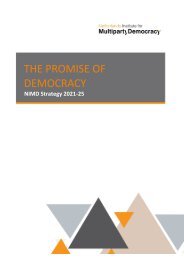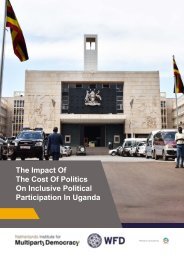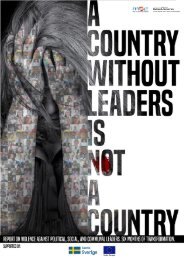Political Party Guidelines Eng
Create successful ePaper yourself
Turn your PDF publications into a flip-book with our unique Google optimized e-Paper software.
Wiki-Gender also lists five steps of gender budgeting: 22
1. An analysis of the situation for women and men and girls and boys (and the different
sub-groups) in a given sector.
2. An assessment of the extent to which the sector’s policy addresses the gender issues and
gaps described in the first step. This step should include an assessment of the relevant
legislation, policies, programs and schemes. It includes an analysis of both the written
policy as well as the implicit policy reflected in government activities. It should examine the
extent to which the above meet the socio-economic and other rights of women.
3. An assessment of the adequacy of budget allocations to implement the gender sensitive
policies and programs identified in step 2 above.
4. Monitoring whether the money was spent as planned, what was delivered and to whom.
This involves checking both financially and the physical deliverables (disaggregated by sex).
5. An assessment of the impact of the policy/program/scheme and the extent to which the
situation described in step 1 has been changed, in the direction of greater gender equality.
According to UN Women, gender responsive budgeting is not: 23
• Separate budgets for women or men. Instead, it brings gender awareness into
the policies, plans, programmes and budgets of all government agencies.
• A literal 50/50 split between men and women. It should be designed in a way that fills
service gaps experienced by both men and women.
• Covering all activities of government because otherwise it will be too long and complicated.
• Only “one way” of reaching set goals; gender responsive budgeting processes will
differ from country to country.
Gender responsive budgeting has been accepted globally as an important and pragmatic
strategy to advance women’s rights. It is a method of planning, programming and budgeting that helps
advance gender equality and women’s rights. It also serves as an indicator of governments’ commitments
to meeting those needs. The government of India adopted gender responsive budgeting in 2005-
06 with the introduction of its first gender budget statement, which made public the quantum of funds
allocated by different ministries, and departments for gender equality and women’s empowerment.
Consequently, 57 government ministries/departments have set up Gender Budget cells – a major step
that could potentially impact the lives of lots of women. 24
GENDER EQUALITY: A SHORTCUT TO DEVELOPMENT AND PROSPERITY 13


















